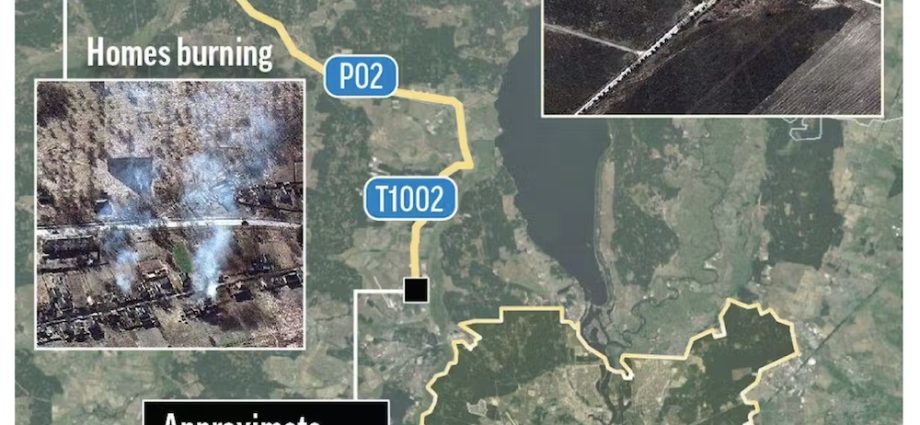As Ukraine’s counteroffensive got underway, there were credible reports of advances into territory previously occupied by Russian troops. Each day brings news of small gains, a village liberated here and a village liberated there.
But Ukraine’s military commanders will know there are much tougher tests to come. Recently published satellite pictures reveal the extent of Russian defensive lines – which are considerable, the result of months of planning and preparation for the counteroffensive.
The big question is whether their planners can take advantage of eyes in the sky to formulate a strategy.
Ukraine possesses no satellites of their own, but nonetheless space technology has played a key role in supporting its operations. When the invasion began Ukraine was quick to call for assistance in tracking and targeting Russian troops. Several commercial satellite providers have since volunteered to provide help.
Ukraine’s ability to call on the assistance of commercial satellites is thought to have given them the edge over Russia’s array of purpose-built military satellites. Russian military satellites are made for battlefield applications and their cameras lack the resolution of those used for industrial purposes.
Russian equipment is also less effective when dealing with cloud cover and darkness. As a result, Russian forces can see less of the battlefield.
The use of space assets has many benefits, not least of which is being able to see what is happening. Ukrainian forces can benefit from high-resolution imagery of events on the ground, often in near real-time.
When on the defensive, this has allowed Ukraine to rapidly react to Russian actions, tracking their troop movements and allowing time to respond to any attempted advances.

Satellites have also helped expose Russian problems with logistics, as well as detect the construction of new military infrastructure.
Navigating Russia’s defenses
Now that Ukrainian forces are advancing, satellite images can again play a pivotal role. As satellite images have revealed, Russia has built an extensive network of trenches, fortifications and minefields, reinforced around areas of particular strategic importance.
If Ukraine is to achieve its objective of severing Russia’s land bridge to Crimea, it will have to contend with these formidable defenses.
Publicly available images show how Russian defenses are structured. Russian engineering represents a series of challenges that will be difficult to overcome.

But, just as importantly, satellites provide a picture of what is taking place behind the lines, permitting strikes against headquarters and logistic hubs. This was a key factor in the preparation for Ukraine’s successful counteroffensives last autumn.
Given the situation on the ground, a likely Ukrainian approach is to continue to leverage their information advantage, probing these defenses with repeated feints and forcing Russian forces to respond.
Having a clear picture of Russia’s defensive array will give Kiev’s commanders in the field both important insights into Russia’s strategy and provide crucial real-time information about where and when to mount its attacks.

Satellite images also provide a range of other insights relevant to the conflict, and ultimately, its aftermath. Imagery available to the public has proved useful in addressing disinformation and shaping public perceptions of the conflict. These images will also furnish vital evidence of war crimes when the conflict ends.
War in space
At the moment, Ukraine’s access to commercial satellites gives it an advantage over Russia – not only in terms of imagery, but also in other areas like communications and targeting. Naturally, Russia would like to address this advantage.
Russia has not only hacked into Western satellites, but threatened to shoot them down. While it certainly has the capability to both disrupt and even destroy space-based assets, the situation is too complex for a direct approach.
Not only are the satellites in question commercial assets, but they do not belong to Ukraine. Any attack runs the risk of expanding the conflict.
Moscow has stressed that commercial satellites represent legitimate targets, but a physical attack against these assets would be unprecedented. It would open up Russian space infrastructure to attack in response. What is more, this would potentially place Russia on course for a direct conflict with the US and other nations.
But this in itself raises a key issue. Access to this sort of capability is expensive, and Ukraine must rely on partners such as the US to pay for its use of commercial space platforms. The Kremlin may hope it can continue in its strategy of attempting to degrade the relationship between Ukraine and its Western allies.
Russia can additionally attempt to jam or disrupt satellites by electronic means, where possible. While Russia does have limitations, it is capable of adaptation, and satellite operators will need to remain vigilant.
Writing in the Financial Times newspaper late last year, former NATO secretary general, Anders Fogh Rasmussen, wrote:
This is the first major conflict where both sides have been heavily reliant on space-based capabilities. It will not be the last.
The use of satellites and GPS technology to pinpoint targets has shown how important this technology is. But it is also vulnerable, as anti-satellite action is being integrated into the tactical battlefield.
Working out how to manage, develop and safeguard space technology will be an increasing focus among military planners.
Christopher Morris is Teaching Fellow, School of Strategy, Marketing and Innovation, University of Portsmouth
This article is republished from The Conversation under a Creative Commons license. Read the original article.

